The Effect of the Ripening Period on the Quality Attributes of Pear Fruit
Abstract
1. Introduction
2. Materials and Methods
2.1. Biological Material
2.2. Assessment of Morphological and Biochemical Attributes of Fruits
2.3. Assessment of Organoleptic Attributes of Fruits
2.4. Statistical Analysis
3. Results
3.1. Morphological, Biochemical, and Colorimetric Attributes of Fruits
3.2. Multivariate Analysis for Morphological, Biochemical, and Colorimetric Attributes of Fruits
3.3. Organoleptic Analysis
4. Discussion
5. Conclusions
Author Contributions
Funding
Data Availability Statement
Conflicts of Interest
Appendix A
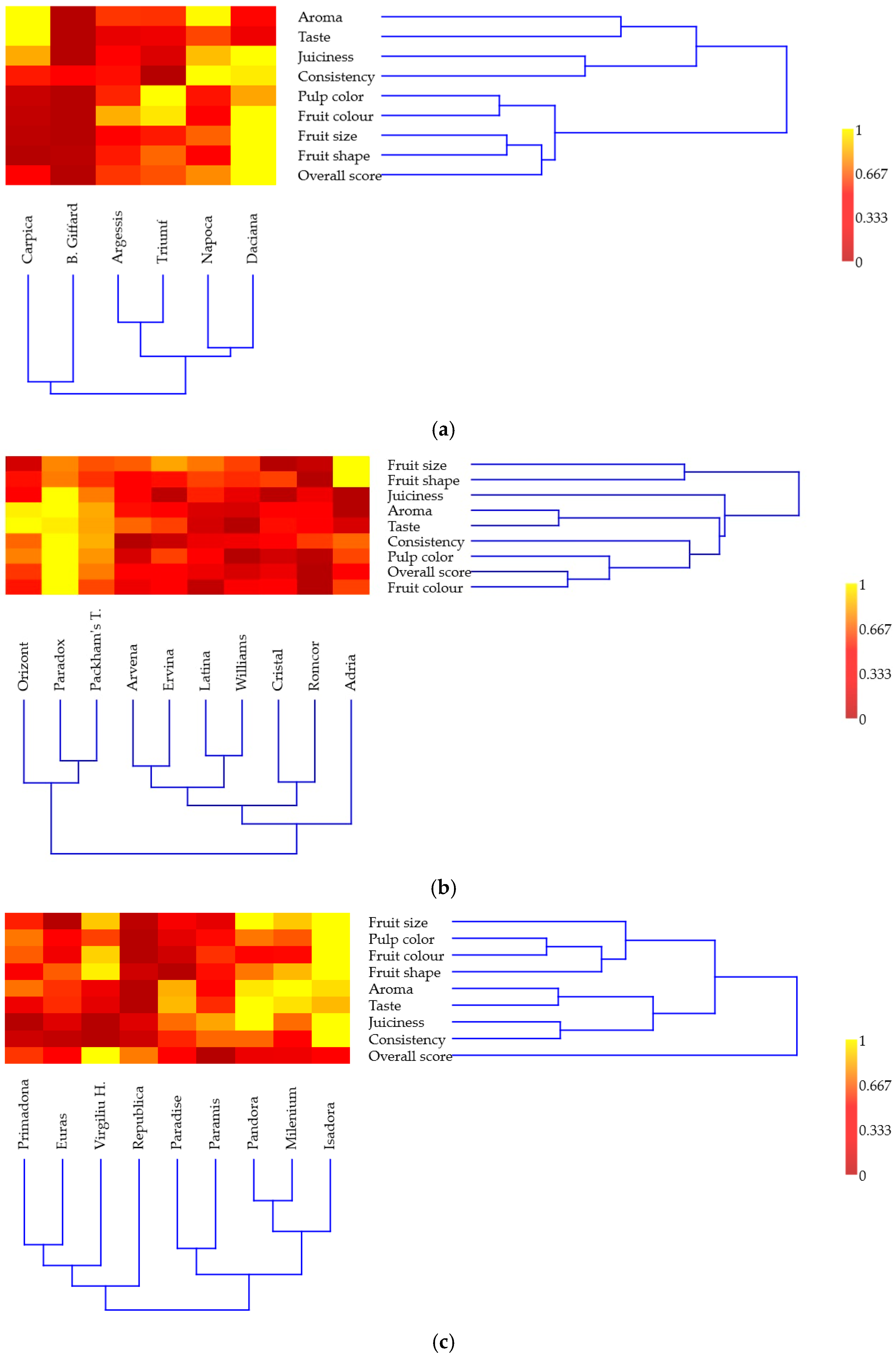
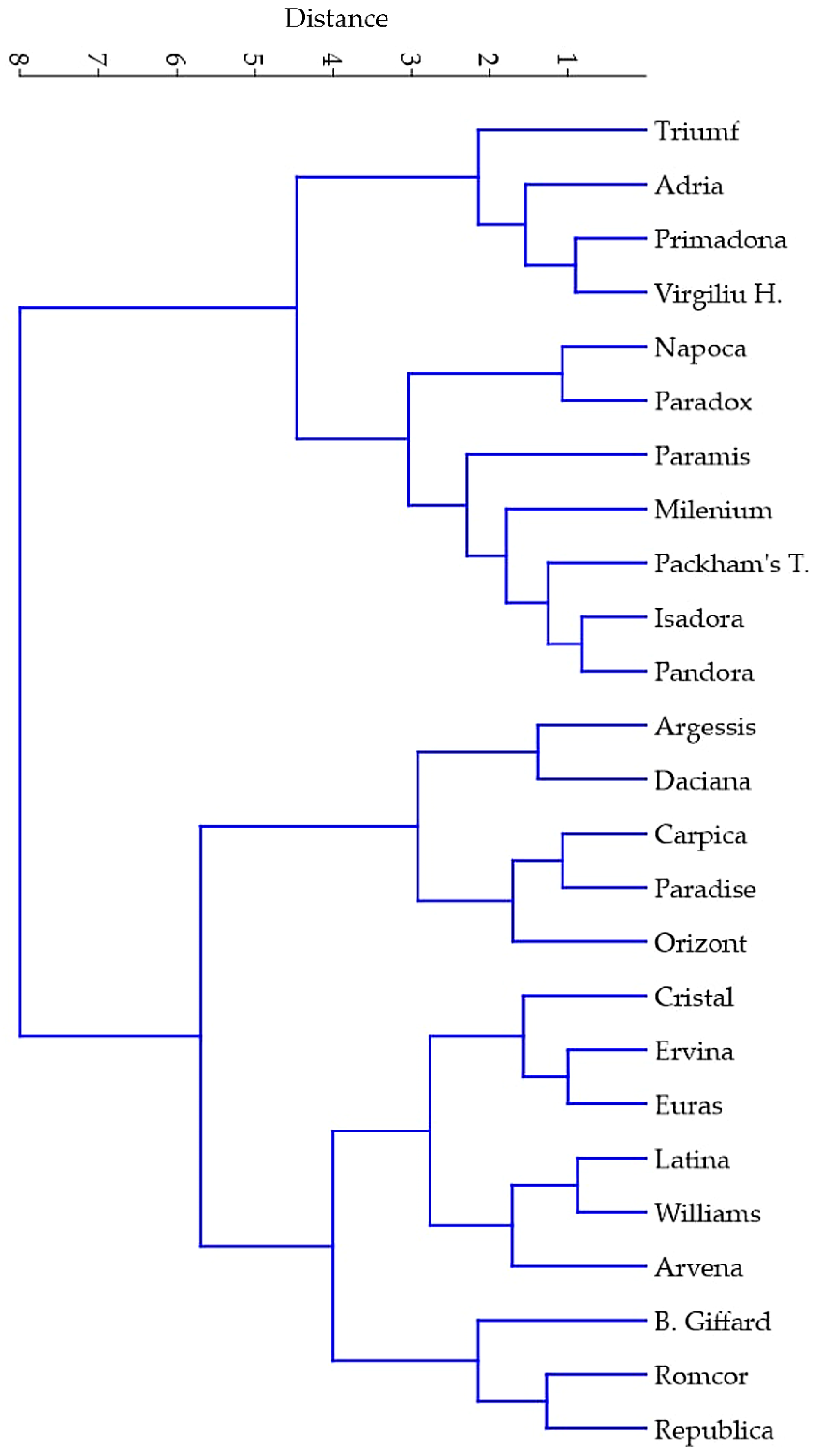
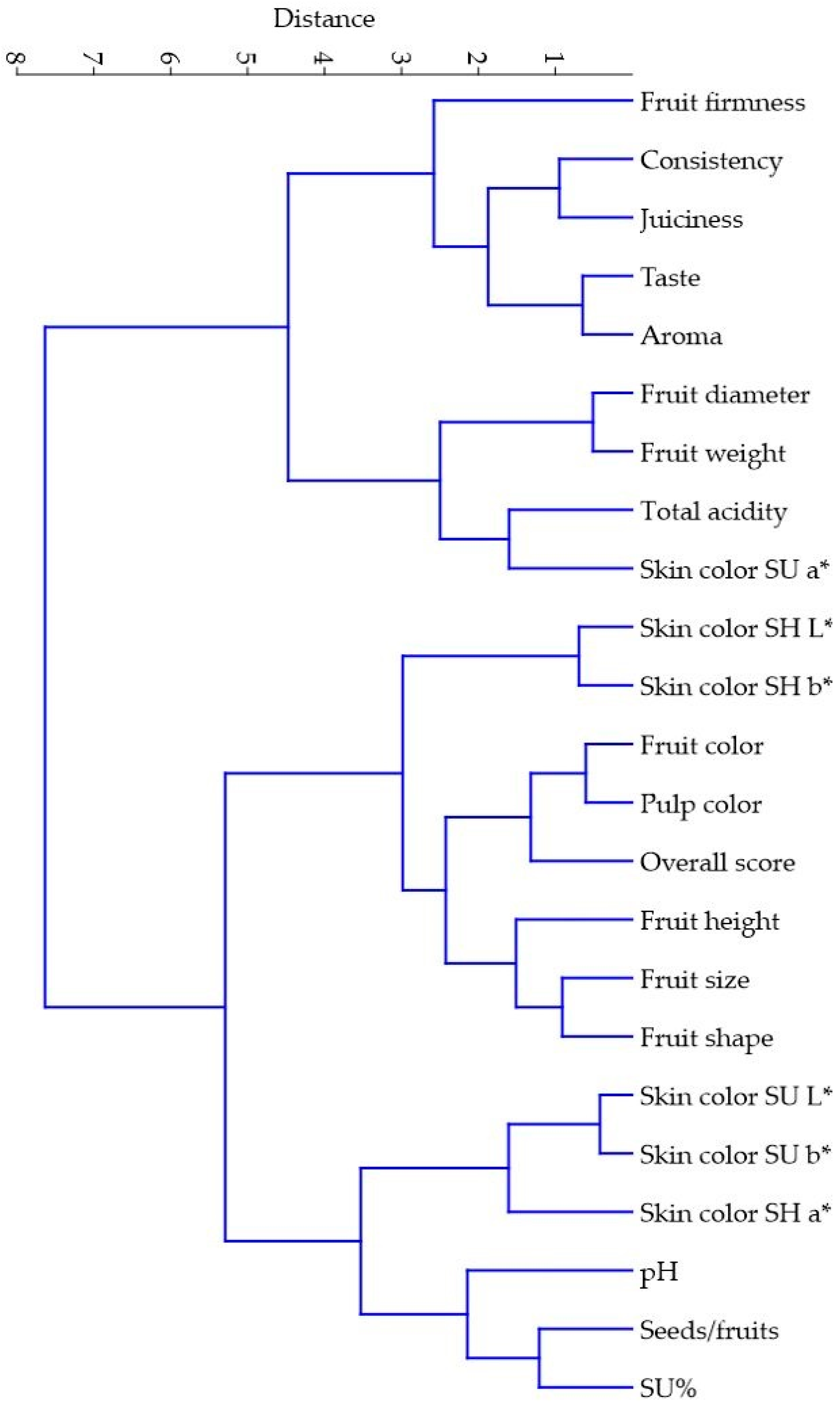
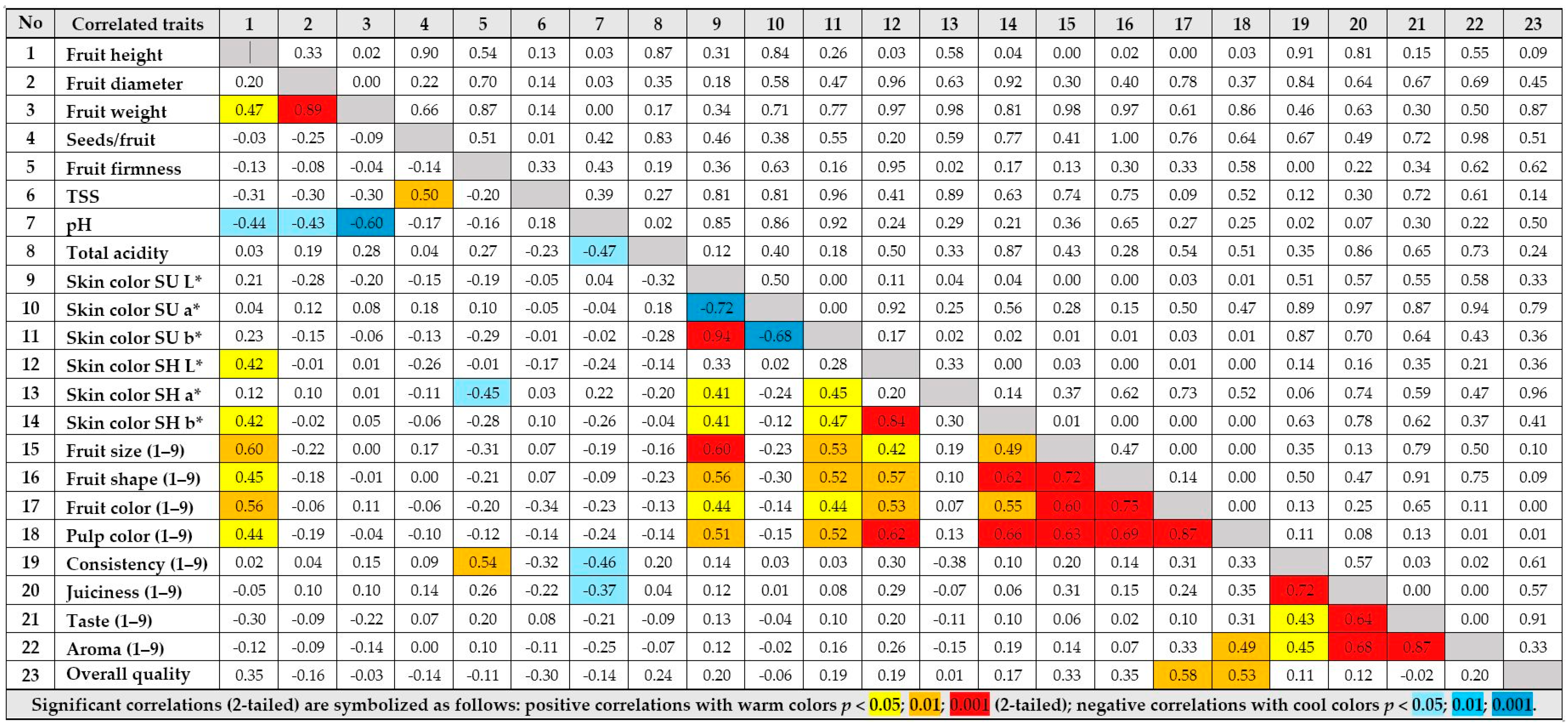
References
- Hong, S.-Y.; Lansky, E.; Kang, S.-S.; Yang, M. A review of pears (Pyrus spp.), ancient functional food for modern times. BMC Complement. Med. Ther. 2021, 21, 219. [Google Scholar] [CrossRef]
- Reiland, H.; Slavin, J. Systematic review of pears and health. Nutr. Today 2015, 50, 301–305. [Google Scholar] [CrossRef] [PubMed]
- Vangdal, E. Quality factors of pears, plums and sweet cherries for fresh consumption. Acta Agric. Scand. 1982, 32, 129–133. [Google Scholar] [CrossRef]
- Blanckenberg, A. Preference of Western Cape Province Consumers for the Eating Quality and Appearance of Pears. Master’s Thesis, Stellenbosch University, Stellenbosch, South Africa, 2015. [Google Scholar]
- Kappel, F.; Fisher-Fleming, R.; Hogue, E.J. Ideal pear sensory attributes and fruit characteristics. HortScience 1995, 30, 988–993. [Google Scholar] [CrossRef]
- Manning, N. Physical, Sensory and Consumer Analysis of Pear Genotypes Among South African Consumers and Preference of Appearance Among European Consumers. Master’s Thesis, Stellenbosch University, Stellenbosch, South Africa, 2009. [Google Scholar]
- Turpin, S.R.; Stefanelli, D.; Jones, L.; Norton, J.; Probst, R.; Konings, J.; Langford, G. Perfect pears for the next generation of consumers. Acta Hortic. 2016, 1120, 507–514. [Google Scholar] [CrossRef]
- Bvenura, C.; Hermaan, N.N.P.; Chen, L.; Sivakumar, D. Nutritional and health benefits of temperate fruits. In Postharvest Biology and Technology of Temperate Fruits; Mir, S.A., Shah, M.A., Mir, M.M., Eds.; Springer International Publishing: Cham, Switzerland, 2018; pp. 51–75. [Google Scholar]
- Dreher, M.L. Whole fruits and fruit fiber emerging health effects. Nutrients 2018, 10, 1833. [Google Scholar] [CrossRef] [PubMed]
- Gorinstein, S.; Martin-Belloso, O.; Lojek, A.; Číž, M.; Soliva-Fortuny, R.; Park, Y.-S.; Caspi, A.; Libman, I.; Trakhtenberg, S. Comparative content of some phytochemicals in Spanish apples, peaches and pears. J. Sci. Food Agric. 2002, 82, 1166–1170. [Google Scholar] [CrossRef]
- Colavita, G.M.; Curetti, M.; Sosa, M.C.; Vita, L.I. Pear. In Temperate Fruits; Apple Academic Press: New York, NY, USA, 2021; pp. 107–182. [Google Scholar]
- Brunetto, G.; Melo, G.W.B.d.; Toselli, M.; Quartieri, M.; Tagliavini, M. The role of mineral nutrition on yields and fruit quality in grapevine, pear and apple. Rev. Bras. Frutic. 2015, 37, 1089–1104. [Google Scholar] [CrossRef]
- Kolniak-Ostek, J. Chemical composition and antioxidant capacity of different anatomical parts of pear (Pyrus communis L.). Food Chem. 2016, 203, 491–497. [Google Scholar] [CrossRef]
- Hammam, W.E.; Gad, A.M.; Gad, M.K.; Kirollos, F.N.; Yassin, N.A.; Tantawi, M.E.E.; El Hawary, S.S.E. Pyrus communis L. (pear) and Malus domestica Borkh. (apple) leaves lipoidal extracts as sources for beta-sitosterol rich formulae and their wound healing evaluation. Nat. Prod. Res. 2023, 37, 2613–2617. [Google Scholar] [CrossRef]
- Li, X.; Wang, T.; Zhou, B.; Gao, W.; Cao, J.; Huang, L. Chemical composition and antioxidant and anti-inflammatory potential of peels and flesh from 10 different pear varieties (Pyrus spp.). Food Chem. 2014, 152, 531–538. [Google Scholar] [CrossRef]
- Kolniak-Ostek, J.; Kłopotowska, D.; Rutkowski, K.P.; Skorupińska, A.; Kruczyńska, D.E. Bioactive compounds and health-promoting properties of pear (Pyrus communis L.) fruits. Molecules 2020, 25, 4444. [Google Scholar] [CrossRef]
- Singh, S.; Verma, R.; Sharma, H. Exploring the therapeutic potential and bioactive compounds in Pyrus species. Pharmacol. Res. Mod. Chin. Med. 2024, 10, 100342. [Google Scholar] [CrossRef]
- Nazir, N.; Nisar, S.; Mubarak, S.; Khalil, A.; Javeed, K.; Banerjee, S.; Kour, J.; Nayik, G.A. Pear. In Antioxidants in Fruits: Properties and Health Benefits; Nayik, G.A., Gull, A., Eds.; Springer: Singapore, 2020; pp. 435–447. [Google Scholar]
- Kathuria, D.; Ramachandran, P.; Gautam, S.; Thakur, A.; Thakur, N. Fruits as a Functional Food for Health. In Functional Foods; CRC Press: Boca Raton, FL, USA, 2023; pp. 49–101. [Google Scholar]
- Navaei, N.; Pourafshar, S.; Akhavan, N.S.; Litwin, N.S.; Foley, E.M.; George, K.S.; Hartley, S.C.; Elam, M.L.; Rao, S.; Arjmandi, B.H.; et al. Influence of daily fresh pear consumption on biomarkers of cardiometabolic health in middle-aged/older adults with metabolic syndrome: A randomized controlled trial. Food Funct. 2019, 10, 1062–1072. [Google Scholar] [CrossRef]
- Gayer, B.A.; Avendano, E.E.; Edelson, E.; Nirmala, N.; Johnson, E.J.; Raman, G. Effects of intake of apples, pears, or their products on cardiometabolic risk factors and clinical outcomes: A systematic review and meta-analysis. Curr. Dev. Nutr. 2019, 3, nzz109. [Google Scholar] [CrossRef] [PubMed]
- James-Martin, G.; Williams, G.; Stonehouse, W.; O’Callaghan, N.; Noakes, M. Health and Nutritional Properties of Pears (Pyrus): A Literature Review. For Hort Innovation and Apple and Pear Australia Ltd. (APAL). Final Report, 15 October 2015. Available online: https://www.australianpears.com.au/wp-content/uploads/2019/10/Pears-Health-Study-AP15010-Final-Report-Complete.pdf (accessed on 12 February 2025).
- Ogah, O.; Ene, C.; Afiukwa, F.; Nwankwo, V. Flavor quality in Rosaceae fruit and nut crops: “Insights into volatile organic compounds and recent breeding strategies”. Niger. J. Biotechn. 2024, 41, 191–211. [Google Scholar] [CrossRef]
- Brewer, L.R.; Palmer, J.W. Global pear breeding programmes: Goals, trends and progress for new cultivars and new rootstocks. Acta Hortic. 2011, 909, 105–119. [Google Scholar] [CrossRef]
- Konopacka, D.; Rutkowski, K.P.; Kruczynska, D.; Skorupinska, A.; Plocharski, W. Quality potential of some new pear cultivars–how to obtain fruit of the best sensory characteristics? J. Hort. Res. 2014, 22, 71–84. [Google Scholar] [CrossRef]
- Dondini, L.; Sansavini, S. European Pear. In Fruit Breeding; Badenes, M.L., Byrne, D.H., Eds.; Springer: Boston, MA, USA, 2012; pp. 369–413. [Google Scholar]
- da Silva, G.J.; Villa, F.; Grimaldi, F.; da Silva, P.S.; Welter, J.F. Pear (Pyrus spp.) Breeding. In Advances in Plant Breeding Strategies: Fruits; Al-Khayri, J.M., Jain, S.M., Johnson, D.V., Eds.; Springer International Publishing: Cham, Switzerland, 2018; Volume 3, pp. 131–163. [Google Scholar]
- Militaru, M.; Coman, M.; Butac, M.; Sturzeanu, M.; Tititrică, I.; Călinescu, M.; Stanciu, C.; Botu, M.; Gavăt, C.; Sîrbu, S.; et al. Fondul de Germoplasmă la Speciile Pomicole Cultivate în România; Editura Invel Multimedia: Otopeni, Romania, 2018. [Google Scholar]
- Paraschiv, M.; Militaru, M.; Hoza, D. Commercial and biochemical quality of Romanian pear genotypes. Sci. Pap. Ser. B Hortic. 2024, 68, 52–60. [Google Scholar]
- Bokszczanin, K.Ł. Future breeding strategies. In The Pear Genome; Korban, S.S., Ed.; Springer International Publishing: Cham, Switzerland, 2019; pp. 301–315. [Google Scholar]
- Takácsné Hájos, M.; Nyéki, J.; Szabó, Z. Organoleptic evaluation of pear varieties grown at different sites. Int. J. Hortic. Sci. 2010, 16, 33–37. [Google Scholar] [CrossRef]
- Cronje, A. Effect of Canopy Position on Fruit Quality and Consumer Preference for the Appearance and Taste of Pears. Master’s Thesis, Stellenbosch University, Stellenbosch, South Africa, 2014. [Google Scholar]
- Bruhn, C.M.; Feldman, N.; Garlitz, C.; Harwood, J.; Ivans, E.; Marshall, M.; Riley, A.; Thurber, D.; Williamson, E. Consumer perceptions of quality: Apricots, cantaloupes, peaches, pears, strawberries, and tomatoes. J. Food Qual. 1991, 14, 187–195. [Google Scholar] [CrossRef]
- Pasquariello, M.S.; Rega, P.; Migliozzi, T.; Capuano, L.R.; Scortichini, M.; Petriccione, M. Effect of cold storage and shelf life on physiological and quality traits of early ripening pear cultivars. Sci. Hortic. 2013, 162, 341–350. [Google Scholar] [CrossRef]
- Tóth-Markus, M.; Bánáti, D.; Adányi, N.; Boross, F.; Konrád-Németh, C.; Szabó, Z.; Soltész, M.; Nyéki, J. Composition and storage of pear cultivars from Nagykanizsa. Int. J. Hortic. Sci. 2011, 17, 63–68. [Google Scholar] [CrossRef]
- Quamme, H.A.; Gray, J.I. Pear fruit quality and factors that condition it. In Evaluation of Quality of Fruits and Vegetables; Pattee, H.E., Ed.; Springer: Dordrecht, The Netherlands, 1985; pp. 47–61. [Google Scholar]
- Gamble, J.; Jaeger, S.R.; Harker, F.R. Preferences in pear appearance and response to novelty among Australian and New Zealand consumers. Postharvest Biol. Technol. 2006, 41, 38–47. [Google Scholar] [CrossRef]
- Gallardo, R.K.; Ma, X.; Colonna, A.; Montero, M.L.; Ross, C. Consumers’ preferences for novel and traditional pear cultivars: Evidence from sensory evaluation and willingness-to-pay elicitation. HortScience 2023, 58, 1474–1483. [Google Scholar] [CrossRef]
- Colonna, A.E.; Gutierrez, J.; Montero, M.L.; Gallardo, R.K.; Ross, C.F. An investigation of consumer pear knowledge, consumer preferences and desirable sensory traits to increase pear consumption. Acta Hortic. 2024, 1403, 53–62. [Google Scholar] [CrossRef]
- Giusti, M.M.; Gordillo, B.; González-Miret, M.L. Color Analysis. In Nielsen’s Food Analysis; Ismail, B.P., Nielsen, S.S., Eds.; Springer International Publishing: Cham, Switzerland, 2024; pp. 509–522. [Google Scholar]
- Magwaza, L.S.; Opara, U.L. Analytical methods for determination of sugars and sweetness of horticultural products—A review. Sci. Hort. 2015, 184, 179–192. [Google Scholar] [CrossRef]
- Wu, J.; Fan, J.; Li, Q.; Jia, L.; Xu, L.; Wu, X.; Wang, Z.; Li, H.; Qi, K.; Qiao, X.; et al. Variation of organic acids in mature fruits of 193 pear (Pyrus spp.) cultivars. J. Food Compos. Anal. 2022, 109, 104483. [Google Scholar] [CrossRef]
- Morariu, P.A.; Mureșan, A.E.; Sestras, A.F.; Dan, C.; Andrecan, A.F.; Borsai, O.; Militaru, M.; Mureșan, V.; Sestras, R.E. The impact of cultivar and production conditions on apple quality. Not. Bot. Horti Agrobot. Cluj-Napoca 2025, 53, 14046. [Google Scholar] [CrossRef]
- Hampson, C.R.; Quamme, H.A.; Hall, J.W.; MacDonald, R.A.; King, M.C.; Cliff, M.A. Sensory evaluation as a selection tool in apple breeding. Euphytica 2000, 111, 79–90. [Google Scholar] [CrossRef]
- Hammer, Ø.; Harper, D.A.T.; Ryan, P.D. PAST: Paleontological statistics software package for education and data analysis. Palaeontol. Electron. 2001, 4, 4–9. [Google Scholar]
- Akagić, A.; Oras, A.; Gaši, F.; Meland, M.; Drkenda, P.; Memić, S.; Spaho, N.; Žuljević, S.O.; Jerković, I.; Musić, O.; et al. A comparative study of ten pear (Pyrus communis L.) cultivars in relation to the content of sugars, organic acids, and polyphenol compounds. Foods 2022, 11, 3031. [Google Scholar] [CrossRef]
- Yin, C.; Tian, L.; Li, J.; Cao, Y.; Dong, X.; Zhang, Y.; Qi, D. Dynamic analysis of UPLC-MS/MS for sugar and organic acid components of pears with different flesh texture types during development. Agronomy 2024, 14, 2494. [Google Scholar] [CrossRef]
- Chen, J.; Wang, Z.; Wu, J.; Wang, Q.; Hu, X. Chemical compositional characterization of eight pear cultivars grown in China. Food Chem. 2007, 104, 268–275. [Google Scholar] [CrossRef]
- Kalkisim, O.; Okcu, Z.; Karabulut, B.; Ozdes, D.; Duran, C. Evaluation of pomological and morphological characteristics and chemical compositions of local pear varieties (Pyrus communis L.) grown in Gumushane, Turkey. Erwerbs-Obstbau 2018, 60, 173–181. [Google Scholar] [CrossRef]
- Predieri, S.; Gatti, E. Effects of cold storage and shelf-life on sensory quality and consumer acceptance of ‘Abate Fetel’ pears. Postharvest Biol. Technol. 2009, 51, 342–348. [Google Scholar] [CrossRef]
- Torregrosa, L.; Echeverria, G.; Illa, J.; Giné-Bordonaba, J. Ripening behaviour and consumer acceptance of ‘Conference’ pears during shelf life after long term DCA-storage. Postharvest Biol. Technol. 2019, 155, 94–101. [Google Scholar] [CrossRef]
- Blanckenberg, A.; Muller, M.; Theron, K.; Crouch, E.M.; Steyn, W.J. Preference of consumers from the Western Cape Province of South Africa for pear eating quality and appearance. Acta Hortic. 2024, 1403, 43–52. [Google Scholar] [CrossRef]
- Pérez-Sánchez, R.; Morales-Corts, M.R. Agromorphological and chemical characterization of pear cultivars grown in Central–West Iberian peninsula. Agronomy 2023, 13, 2993. [Google Scholar] [CrossRef]
- HongMei, M.; Shujun, Z.; Qiang, G.; Aishajiang, M.; Xiaoyun, D.; Yuanjun, L.; Zhijuan, C. Variability of Pyrus communis accessions in China assessed using multivariate analysis. Eur. J. Hortic. Sci. 2022, 87, 1–11. [Google Scholar] [CrossRef]
- Zarei, A.; Erfani-Moghadam, J.; Jalilian, H. Assessment of variability within and among four Pyrus species using multivariate analysis. Flora 2019, 250, 27–36. [Google Scholar] [CrossRef]
- Zhang, Y.; Cao, Y.-f.; Huo, H.-l.; Xu, J.-y.; Tian, L.-m.; Dong, X.-g.; Qi, D.; Liu, C. An assessment of the genetic diversity of pear (Pyrus L.) germplasm resources based on the fruit phenotypic traits. J. Integr. Agric. 2022, 21, 2275–2290. [Google Scholar] [CrossRef]
- Simionca Mărcășan, L.I.; Oltean, I.; Popa, S.; Plazas, M.; Vilanova, S.; Gramazio, P.; Sestras, A.F.; Prohens, J.; Sestras, R.E. Comparative analysis of phenotypic and molecular data on response to main pear diseases and pest attack in a germplasm collection. Int. J. Mol. Sci. 2023, 24, 6239. [Google Scholar] [CrossRef]
- Simionca Mărcășan, L.I.; Pop, R.; Somsai, P.A.; Oltean, I.; Popa, S.; Sestras, A.F.; Militaru, M.; Botu, M.; Sestras, R.E. Comparative evaluation of Pyrus species to identify possible resources of interest in pear breeding. Agronomy 2023, 13, 1264. [Google Scholar] [CrossRef]
- Sharma, A.; Thakur, D.S.; Dangi, G.; Chauhan, N.; Verma, P. Qualitative and quantitative analysis of pear (Pyrus communis L.) germplasm for morphological and pomological traits using multivariate analysis. Appl. Fruit Sci. 2025, 67, 27. [Google Scholar] [CrossRef]
- Shafaei-Cherush, Z.; Arzani, K.; Ahmadi, N.; Mokhtassi-Bidgoli, A.; Ayyari, M.; Abdollahi, H. Improving pear (Pyrus spp.) harvest maturity assessment: Integration of color composite indicators and sophisticated multivariate analysis techniques. J. Agric. Food Res. 2025, 19, 101596. [Google Scholar] [CrossRef]
- Zheng, P.; Zhang, M.; Wang, Z.; Wang, T.; Tang, L.; Ma, E.; Liu, J.; Shi, F. Comprehensive evaluation of the fruit quality of the main cultivars of pear (Pyrus spp.) in North China. Erwerbs-Obstbau 2022, 64, 219–227. [Google Scholar] [CrossRef]
- Zhang, Y.; Cheng, Y.; Ma, Y.; Guan, J.; Zhang, H. Regulation of pear fruit quality: A review based on Chinese pear varieties. Agronomy 2025, 15, 58. [Google Scholar] [CrossRef]
- Paraschiv, M.; Maresi, E.; Militaru, M.; Hoza, D. Influence of genotypes and the storage time on pears quality indicators. Sci. Pap. Ser. B Hortic. 2024, 68, 128–138. [Google Scholar]
- Dan, G.; Ruth, B.-A.; Martin, G. Optimizing the harvest date for long-term storage of ‘Spadona’ pears (Pyrus communis L.) by prediction of the pre-climacteric minimum. Sci. Hortic. 2015, 197, 280–286. [Google Scholar] [CrossRef]
- Taiti, C.; Marone, E.; Lanza, M.; Azzarello, E.; Masi, E.; Pandolfi, C.; Giordani, E.; Mancuso, S. Nashi or Williams pear fruits? Use of volatile organic compounds, physicochemical parameters, and sensory evaluation to understand the consumer’s preference. Eur. Food Res. Technol. 2017, 243, 1917–1931. [Google Scholar] [CrossRef]
- Dan, C.; Șerban, C.; Sestras, A.F.; Militaru, M.; Morariu, P.; Sestras, R.E. Consumer perception concerning apple fruit quality, depending on cultivars and hedonic scale of evaluation—A case study. Not. Sci. Biol. 2015, 7, 140–149. [Google Scholar] [CrossRef]
- Morariu, P.A.; Mureșan, A.E.; Sestras, A.F.; Tanislav, A.E.; Dan, C.; Mareși, E.; Militaru, M.; Mureșan, V.; Sestras, R.E. A comprehensive morphological, biochemical, and sensory study of traditional and modern apple cultivars. Horticulturae 2025, 11, 264. [Google Scholar] [CrossRef]
- Lozano, L.; Iglesias, I.; Puy, J.; Echeverria, G. Performance of an expert sensory panel and instrumental measures for assessing eating fruit quality attributes in a pear breeding programme. Foods 2023, 12, 1426. [Google Scholar] [CrossRef]
- Rivaroli, S.; Calvia, M.; Spadoni, R.; Tartarini, S.; Gregori, R.; Calvo-Porral, C.; Canavari, M. Sensory perception and willingness to pay for a local ancient pear variety: Evidence from in-store experiments in Italy. Foods 2024, 13, 138. [Google Scholar] [CrossRef]
- Montero, M.L.; Colonna, A.E.; Gallardo, R.K.; Ross, C.F. Sensory profiling of pears from the Pacific Northwest: Consumers’ perspective and descriptive analysis. J. Food Sci. 2024, 89, 1225–1242. [Google Scholar] [CrossRef]
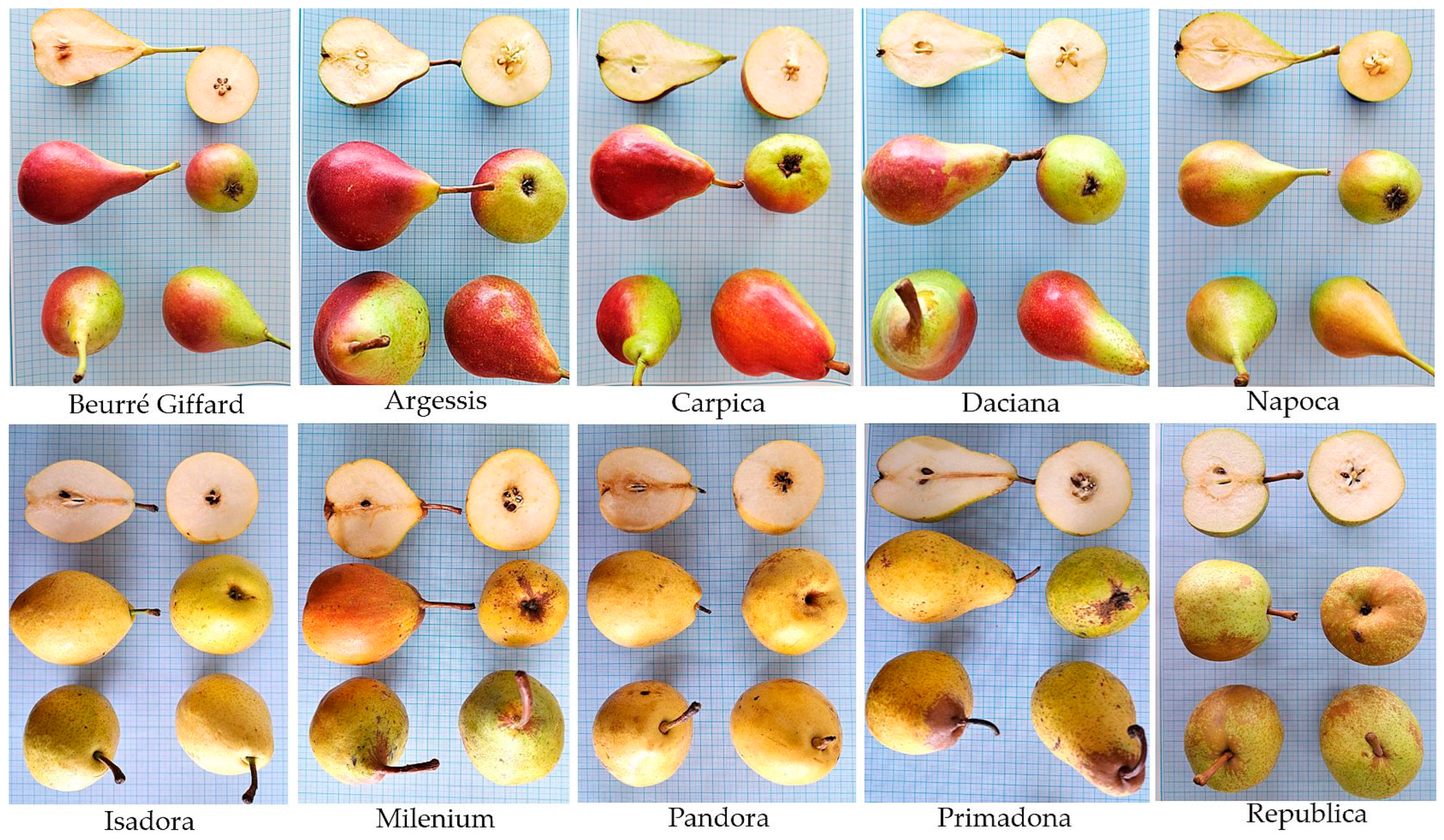
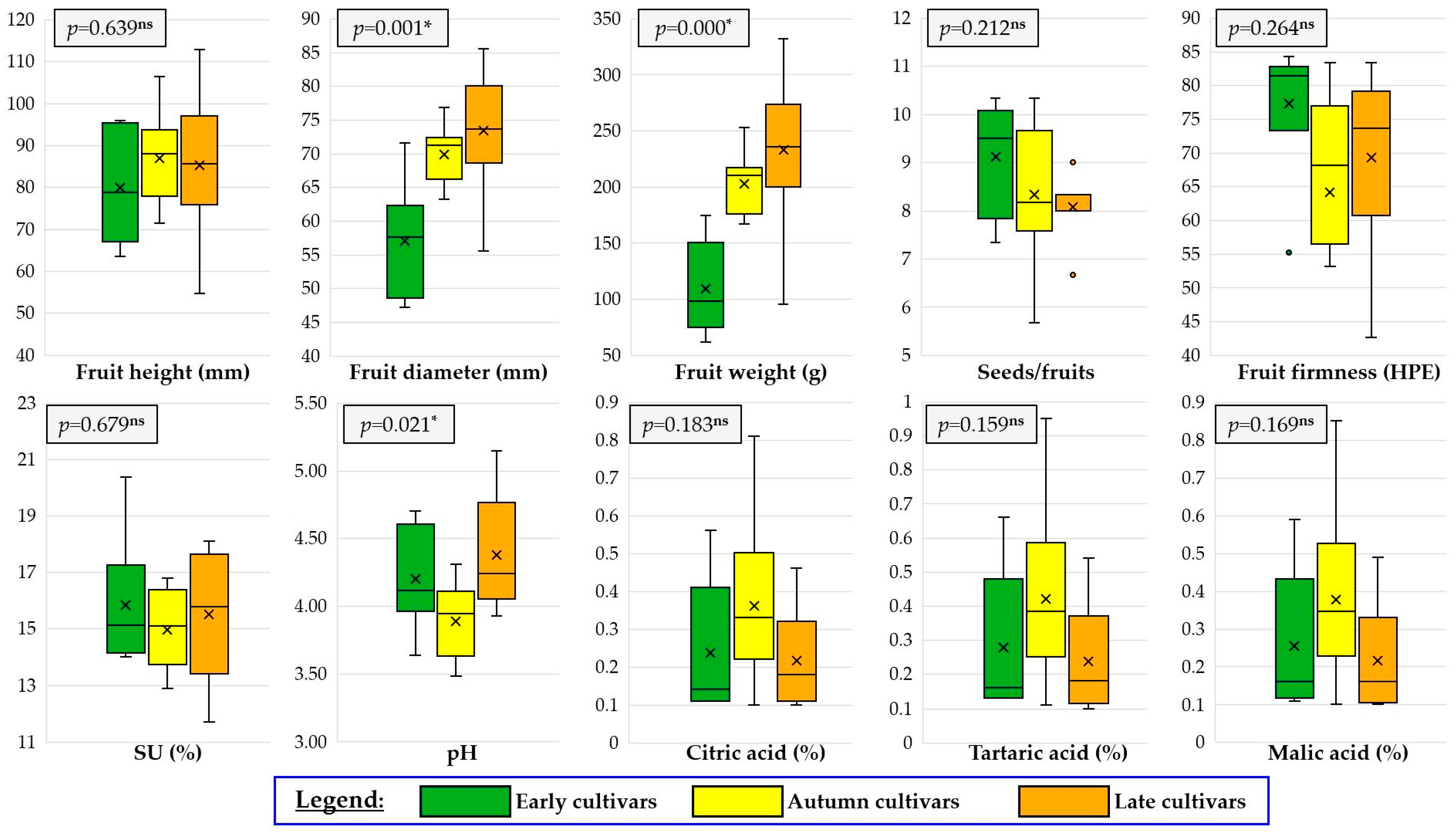
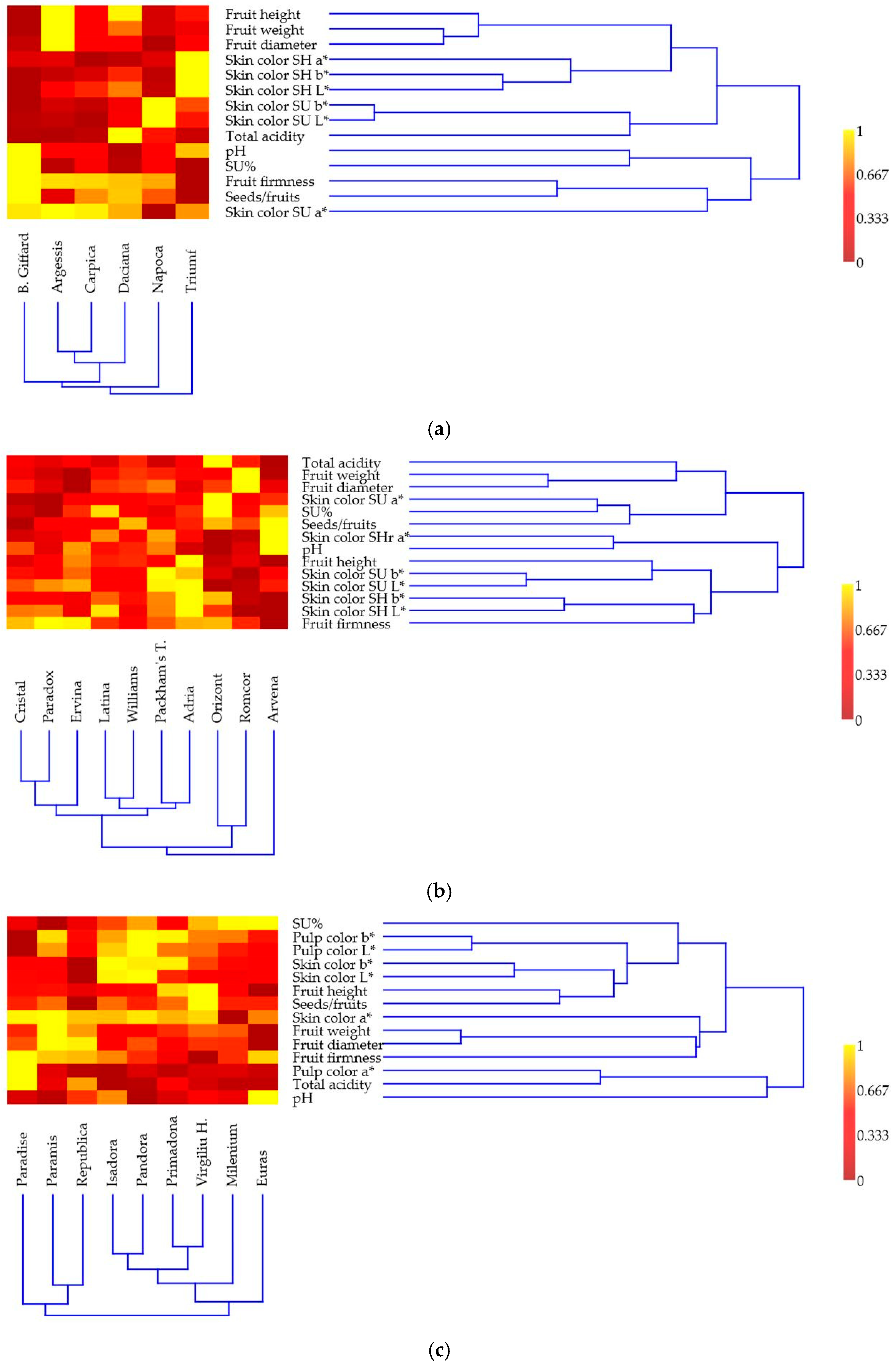


| Cultivar | Fruit Height (mm) | Fruit Diameter (mm) | Fruit Weight (g) | Seeds/Fruit | Fruit Firmness (HPE) |
|---|---|---|---|---|---|
| Early-ripening | |||||
| ‘Triumf’ | 81.1 ± 5.2 b | 57.1 ± 2.8 b | 91.9 ± 4.5 d | 7.33 ± 0.3 b | 55.2 ± 0.6 b |
| ‘B. Giffard’ | 63.4 ± 3.1 c | 48.9 ± 2.3 c | 61.4 ± 4.5 f | 10.33 ± 0.4 a | 84.3 ± 0.8 a |
| ‘Argessis’ | 95.8 ± 2.3 a | 71.6 ± 0.3 a | 174.2 ± 3.0 a | 8.00 ± 0.6 b | 82.2 ± 1.2 a |
| ‘Carpica’ | 76.2 ± 4.0 b | 59.3 ± 0.4 b | 104.0 ± 0.8 c | 9.76 ± 0.4 a | 82.0 ± 2.1 a |
| ‘Napoca’ | 68.1 ± 0.8 c | 47.2 ± 0.3 c | 78.6 ± 1.7 e | 9.33 ± 0.7 a | 79.2 ± 0.8 a |
| ‘Daciana’ | 95.1 ± 5.3 a | 58.0 ± 2.4 a | 142.5 ± 6.4 b | 10.00 ± 0.6 a | 80.8 ± 0.9 a |
| Autumn-ripening | |||||
| ‘Adria’ | 106.4 ± 4.1 a | 66.3 ± 2.9 b | 211.4 ± 11.7 b | 8.33 ± 0.9 bc | 73.2 ± 6.1 b |
| ‘Arvena’ | 71.3 ± 1.5 c | 66.7 ± 0.7 b | 168.6 ± 0.2 c | 10.33 ± 0.3 a | 21.4 ± 1.2 e |
| ‘Cristal’ | 78.9 ± 2.3 bc | 70.8 ± 2.1 ab | 190.9 ± 8.8 bc | 5.76 ± 0.7 d | 75.2 ± 0.5 ab |
| ‘Ervina’ | 98.0 ± 3.0 ab | 63.2 ± 1.0 b | 166.9 ± 13.1 c | 8.00 ± 0.6 bc | 81.8 ± 5.2 ab |
| ‘Latina’ | 91.5 ± 1.2 b | 71.5 ± 1.5 ab | 212.3 ± 15.2 b | 8.00 ± 0.1 bc | 58.3 ± 3.7 cd |
| ‘Orizont’ | 74.8 ± 0.8 c | 71.7 ± 0.4 ab | 208.5 ± 3.5 b | 9.76 ± 0.7 a | 74.5 ± 0.8 ab |
| ‘Paradox’ | 88.4 ± 2.3 b | 66.0 ± 1.3 b | 178.0 ± 6.2 c | 7.73 ± 0.3 c | 83.3 ± 1.5 a |
| ‘Romcor’ | 79.6 ± 3.2 bc | 76.8 ± 0.9 a | 253.1 ± 11.2 a | 8.76 ± 0.3 b | 57.5 ± 3.9 cd |
| ‘Packham’s T.’ | 87.6 ± 2.1 b | 73.2 ± 0.8 ab | 215.9 ± 7.8 b | 7.33 ± 0.4 c | 63.1 ± 3.6 c |
| ‘Williams’ | 92.1 ± 1.2 b | 72.0 ± 0.7 ab | 219.7 ± 9.9 b | 9.76 ± 0.3 a | 53.2 ± 4.8 d |
| Late-ripening | |||||
| ‘Euras’ | 54.7 ± 2.5 d | 55.5 ± 0.2 c | 95.4 ± 2.3 e | 8.00 ± 0.6 a | 79.4 ± 1.6 b |
| ‘Isadora’ | 82.9 ± 4.1 b | 66.8 ± 2.1 b | 192.3 ± 13.8 d | 8.33 ± 0.3 a | 73.7 ± 1.7 bc |
| ‘Pandora’ | 85.6 ± 1.8 b | 75.4 ± 1.5 b | 207.3 ± 2.5 d | 8.00 ± 0.6 a | 66.5 ± 2.8 c |
| ‘Paradise’ | 85.7 ± 1.8 b | 75.4 ± 1.5 b | 233.7 ± 7.8 c | 8.00 ± 0.6 a | 83.3 ± 0.5 a |
| ‘Milenium’ | 82.8 ± 3.7 b | 73.2 ± 2.2 b | 253.7 ± 30.1 bc | 8.00 ± 0.6 a | 66.7 ± 3.7 c |
| ‘Primadona’ | 107.9 ± 2.2 a | 70.2 ± 0.9 b | 235.3 ± 9.0 c | 8.33 ± 0.3 a | 55.0 ± 5.1 d |
| ‘Virgiliu H.’ | 112.7 ± 5.9 a | 73.6 ± 1.2 b | 261.7 ± 14.0 bc | 9.00 ± 0.6 a | 42.6 ± 3.0 e |
| ‘Paramis’ | 86.0 ± 1.0 b | 85.6 ± 1.1 a | 332.0 ± 12.2 a | 8.33 ± 0.9 a | 78.8 ± 3.3 b |
| ‘Republica’ | 68.7 ± 2.4 c | 84.7 ± 1.8 a | 284.9 ± 12.8 b | 6.76 ± 0.3 b | 77.6 ± 0.3 b |
| Cultivar | TSS (%) | pH | Citric Acid (%) | Tartaric Acid (%) | Malic Acid (%) |
|---|---|---|---|---|---|
| Early-ripening | |||||
| ‘Triumf’ | 14.0 ± 0.2 c | 4.57 ± 0.1 a | 0.15 ± 0.02 c | 0.16 ± 0.02 c | 0.18 ± 0.02 c |
| ‘B. Giffard’ | 20.4 ± 0.3 a | 4.70 ± 0.1 a | 0.11 ± 0.01 e | 0.13 ± 0.01 e | 0.12 ± 0.01 e |
| ‘Argessis’ | 14.3 ± 0.3 c | 4.11 ± 0.0 b | 0.11 ± 0.01 e | 0.13 ± 0.01 e | 0.11 ± 0.01 e |
| ‘Carpica’ | 16.0 ± 0.4 b | 4.07 ± 0.0 b | 0.13 ± 0.01 d | 0.16 ± 0.02 d | 0.14 ± 0.02 d |
| ‘Napoca’ | 16.2 ± 0.3 b | 4.13 ± 0.1 b | 0.36 ± 0.03 b | 0.42 ± 0.03 b | 0.38 ± 0.04 b |
| ‘Daciana’ | 14.2 ± 0.5 c | 3.63 ± 0.1 c | 0.56 ± 0.04 a | 0.66 ± 0.07 a | 0.59 ± 0.07 a |
| Autumn-ripening | |||||
| ‘Adria’ | 15.2 ± 0.4 b | 3.60 ± 0.2 b | 0.34 ± 0.02 c | 0.40 ± 0.03 c | 0.36 ± 0.02 c |
| ‘Arvena’ | 16.3 ± 0.5 ab | 4.31 ± 0.1 a | 0.10 ± 0.01 g | 0.11 ± 0.01 g | 0.10 ± 0.01 g |
| ‘Cristal’ | 13.4 ± 0.1 c | 4.02 ± 0.1 ab | 0.32 ± 0.02 c | 0.37 ± 0.04 c | 0.33 ± 0.04 c |
| ‘Ervina’ | 15.2 ± 0.2 b | 4.14 ± 0.1 a | 0.35 ± 0.03 c | 0.41 ± 0.05 c | 0.36 ± 0.02 c |
| ‘Latina’ | 16.5 ± 0.7 a | 3.92 ± 0.1 ab | 0.23 ± 0.02 e | 0.26 ± 0.01 e | 0.24 ± 0.01 e |
| ‘Orizont’ | 16.8 ± 0.8 a | 3.48 ± 0.2 b | 0.81 ± 0.05 a | 0.95 ± 0.07 a | 0.85 ± 0.09 a |
| ‘Paradox’ | 12.9 ± 0.2 c | 3.66 ± 0.1 b | 0.26 ± 0.02 d | 0.31 ± 0.02 d | 0.28 ± 0.05 d |
| ‘Romcor’ | 15.0 ± 0.3 b | 3.64 ± 0.2 b | 0.50 ± 0.04 b | 0.58 ± 0.03 b | 0.52 ± 0.07 b |
| ‘Packham’s T.’ | 13.8 ± 0.4 bc | 4.10 ± 0.1 a | 0.19 ± 0.02 f | 0.22 ± 0.01 f | 0.19 ± 0.02 f |
| ‘Williams’ | 14.4 ± 0.3 bc | 3.96 ± 0.1 ab | 0.51 ± 0.06 b | 0.60 ± 0.07 b | 0.54 ± 0.06 b |
| Late-ripening | |||||
| ‘Euras’ | 18.1 ± 0.3 a | 5.15 ± 0.1 a | 0.18 ± 0.2 e | 0.10 ± 0.2 i | 0.10 ± 0.2 g |
| ‘Isadora’ | 15.8 ± 0.1 b | 4.87 ± 0.1 a | 0.10 ± 0.1 h | 0.11 ± 0.1 hi | 0.10 ± 0.1 g |
| ‘Pandora’ | 17.0 ± 0.2 ab | 3.93 ± 0.3 b | 0.10 ± 0.2 h | 0.12 ± 0.2 gh | 0.11 ± 0.2 g |
| ‘Paradise’ | 13.4 ± 0.1 c | 4.13 ± 0.2 b | 0.46 ± 0.6 a | 0.54 ± 0.7 a | 0.49 ± 0.7 a |
| ‘Milenium’ | 18.0 ± 0.1 a | 4.24 ± 0.1 b | 0.12 ± 0.2 g | 0.14 ± 0.2 f | 0.12 ± 0.2 f |
| ‘Primadona’ | 14.9 ± 0.2 b | 4.13 ± 0.1 b | 0.24 ± 0.5 c | 0.28 ± 0.5 c | 0.25 ± 0.6 c |
| ‘Virgiliu H.’ | 17.2 ± 0.1 ab | 4.34 ± 0.1 b | 0.15 ± 0.2 f | 0.18 ± 0.2 e | 0.16 ± 0.2 e |
| ‘Paramis’ | 11.7 ± 0.4 d | 3.97 ± 0.2 b | 0.20 ± 0.2 d | 0.21 ± 0.3 d | 0.20 ± 0.5 d |
| ‘Republica’ | 13.3 ± 0.2 c | 4.66 ± 0.1 ab | 0.40 ± 0.3 b | 0.46 ± 0.6 b | 0.41 ± 0.7 b |
| Cultivar | Skin Color—Sunny Side | Skin Color—Shading Side | ||||
|---|---|---|---|---|---|---|
| L* | a* | b* | L* | a* | b* | |
| Early-ripening | ||||||
| ‘Triumf’ | 44.5 ± 5.0 b | 16.4 ± 7.7 b | 19.4 ± 3.0 b | 70.9 ± 0.8 a | −8.5 ± 2.6 c | 33.4 ± 1.2 a |
| ‘B. Giffard’ | 34.0 ± 0.4 d | 19.0 ± 1.2 a | 10.7 ± 0.4 e | 61.0 ± 1.2 b | −14.2 ± 0.3 b | 27.3 ± 0.5 b |
| ‘Argessis’ | 34.8 ± 1.7 d | 20.0 ± 1.1 a | 12.6 ± 1.2 d | 65.1 ± 1.6 a | −14.0 ± 0.3 b | 27.8 ± 0.4 b |
| ‘Carpica’ | 33.4 ± 0.5 d | 19.4 ± 0.3 a | 11.6 ± 0.9 de | 66.7 ± 0.3 a | −15.6 ± 0.3 a | 28.3 ± 0.3 b |
| ‘Napoca’ | 53.6 ± 2.1 a | 3.0 ± 0.7 c | 24.1 ± 1.3 a | 61.7 ± 1.3 ab | −14.3 ± 0.4 b | 27.6 ± 0.3 b |
| ‘Daciana’ | 39.7 ± 5.1 c | 17.2 ± 3.5 b | 14.6 ± 2.4 c | 68.4 ± 1.1 a | −15.2 ± 0.7 a | 30.8 ± 0.4 ab |
| Autumn-ripening | ||||||
| ‘Adria’ | 66.9 ± 4.7 a | −2.7 ± 5.0 | 30.6 ± 2.8 ab | 68.6 ± 2.3 a | −6.7 ± 0.5 | 31.9 ± 1.6 a |
| ‘Arvena’ | 59.0 ± 2.1 b | −0.2 ± 1.6 | 27.2 ± 1.0 b | 55.5 ± 1.0 b | 0.8 ± 0.7 | 25.2 ± 0.6 b |
| ‘Cristal’ | 60.8 ± 4.5 ab | −10.9 ± 0.8 | 27.7 ± 1.6 b | 65.1 ± 0.8 a | −12.8 ± 0.1 | 28.6 ± 0.5 ab |
| ‘Ervina’ | 64.1 ± 3.3 ab | −5.6 ± 0.3 | 29.1 ± 1.2 ab | 59.2 ± 0.7 ab | −7.7 ± 1.2 | 27.1 ± 0.4 ab |
| ‘Latina’ | 56.8 ± 5.0 b | −2.9 ± 6.0 | 26.1 ± 2.4 b | 68.0 ± 1.8 a | −2.7 ± 3.2 | 29.8 ± 0.9 a |
| ‘Orizont’ | 49.1 ± 0.1 c | 8.1 ± 0.3 | 24.6 ± 0.6 bc | 63.5 ± 1.1 a | −15.2 ± 0.4 | 31.1 ± 0.4 a |
| ‘Paradox’ | 63.0 ± 1.1 ab | −11.8 ± 1.1 | 27.2 ± 0.4 b | 65.4 ± 1.7 a | −11.3 ± 1.9 | 28.1 ± 0.5 |
| ‘Romcor’ | 50.3 ± 2.9 c | −3.5 ± 4.9 | 22.9 ± 1.5 c | 55.5 ± 2.6 b | −13.9 ± 0.3 | 25.7 ± 1.0 b |
| ‘Packham’s T.’ | 66.5 ± 1.8 a | −1.0 ± 1.7 | 31.8 ± 0.5 a | 65.4 ± 1.7 a | −2.1 ± 0.3 | 30.3 ± 0.4 a |
| ‘Williams’ | 56.2 ± 4.0 b | −4.8 ± 4.0 | 27.3 ± 2.6 b | 59.3 ± 2.2 ab | −8.5 ± 0.2 | 28.8 ± 1.1 a |
| Late-ripening | ||||||
| ‘Euras’ | 55.9 ± 2.0 b | −3.3 ± 3.4 | 25.1 ± 1.4 c | 60.9 ± 2.1 b | −13.1 ± 0.5 | 27.8 ± 0.8 bc |
| ‘Isadora’ | 68.3 ± 1.8 a | −7.0 ± 0.5 | 29.8 ± 4.4 b | 73.4 ± 1.7 a | −6.0 ± 0.6 | 33.6 ± 0.3 a |
| ‘Pandora’ | 71.4 ± 0.6 a | −1.1 ± 1.1 | 33.0 ± 0.6 a | 73.8 ± 1.0 a | −1.3 ± 0.3 | 33.2 ± 1.0 a |
| ‘Paradise’ | 41.1 ± 1.1 c | 25.2 ± 1.6 | 15.6 ± 0.8 d | 63.2 ± 3.6 b | 0.4 ± 0.2 | 27.5 ± 1.5 bc |
| ‘Milenium’ | 58.2 ± 0.7 b | −1.0 ± 2.3 | 28.4 ± 1.9 b | 58.6 ± 1.6 b | −3.2 ± 1.5 | 28.7 ± 2.3 bc |
| ‘Primadona’ | 63.3 ± 0.3 ab | −5.2 ± 0.7 | 32.6 ± 0.4 a | 64.6 ± 1.4 b | −6.9 ± 1.3 | 33.3 ± 0.8 a |
| ‘Virgiliu H.’ | 62.8 ± 2.3 ab | −1.2 ± 0.2 | 28.7 ± 1.7 b | 60.2 ± 2.5 b | −3.1 ± 2.8 | 29.8 ± 1.0 b |
| ‘Paramis’ | 65.5 ± 2.4 ab | −0.2 ± 0.6 | 31.7 ± 4.1 a | 61.4 ± 3.2 b | 1.7 ± 1.3 | 26.8 ± 1.1 c |
| ‘Republica’ | 54.6 ± 4.1 b | −6.4 ± 2.0 | 24.7 ± 1.7 c | 51.9 ± 4.4 c | −5.4 ± 1.8 | 23.4 ± 1.7 d |
| No. | Cultivar | Fruit Size | Fruit Shape | Fruit Color | Pulp Color | Consistency | Juiciness | Taste | Aroma |
|---|---|---|---|---|---|---|---|---|---|
| Early cultivars | |||||||||
| 1 | ‘Triumf’ | 6.8 ± 0.4 b | 7.8 ± 0.2 ab | 8.1 ± 0.4 a | 8.2 ± 0.5 a | 6.3 ± 0.3 c | 6.4 ± 0.4 bc | 6.7 ± 0.4 b | 6.8 ± 0.4 b |
| 2 | ‘B. Giffard’ | 4.8 ± 0.2 c | 6.7 ± 0.4 c | 6.5 ± 0.2 c | 6.5 ± 0.3 c | 6.8 ± 0.4 b | 6.2 ± 0.3 c | 6.4 ± 0.3 b | 5.9 ± 0.2 c |
| 3 | ‘Argessis’ | 6.6 ± 0.3 b | 7.6 ± 0.3 b | 7.9 ± 0.3 b | 7.5 ± 0.4 b | 6.9 ± 0.2 b | 6.6 ± 0.4 b | 6.6 ± 0.4 b | 6.8 ± 0.4 b |
| 4 | ‘Carpica’ | 4.9 ± 0.1 c | 6.7 ± 0.2 c | 6.6 ± 0.2 c | 6.6 ± 0.2 c | 6.9 ± 0.1 b | 7.2 ± 0.5 a | 7.4 ± 0.3 a | 7.4 ± 0.5 a |
| 5 | ‘Napoca’ | 7.3 ± 0.3 ab | 7.3 ± 0.3 b | 7.3 ± 0.4 b | 7.5 ± 0.3 b | 7.4 ± 0.4 a | 7.2 ± 0.3 a | 7.1 ± 0.5 a | 7.3 ± 0.4 a |
| 6 | ‘Daciana’ | 8.4 ± 0.4 a | 8.2 ± 0.4 a | 8.2 ± 0.5 a | 7.9 ± 0.4 a | 7.3 ± 0.5 a | 7.3 ± 0.4 a | 6.7 ± 0.2 b | 6.7 ± 0.3 b |
| Autumn cultivars | |||||||||
| 1 | ‘Adria’ | 8.8 ± 0.6 a | 9.0 ± 0.3 a | 8.0 ± 0.6 b | 8.0 ± 0.4 b | 7.7 ± 0.7 ab | 7.0 ± 0.6 c | 6.4 ± 0.2 c | 6.0 ± 0.2 c |
| 2 | ‘Arvena’ | 8.2 ± 0.3 b | 7.4 ± 0.5 c | 7.3 ± 0.3 d | 7.5 ± 0.6 c | 6.9 ± 0.4 c | 7.6 ± 0.3 b | 7.4 ± 0.4 ab | 7.2 ± 0.4 b |
| 3 | ‘Cristal’ | 7.0 ± 0.5 c | 7.9 ± 0.2 bc | 7.6 ± 0.5 c | 7.5 ± 0.3 c | 7.4 ± 0.3 b | 7.0 ± 0.4 b | 7.1 ± 0.3 b | 7.1 ± 0.5 b |
| 4 | ‘Ervina’ | 8.5 ± 0.4 b | 7.6 ± 0.4 c | 7.5 ± 0.2 c | 8.0 ± 0.6 b | 7.0 ± 0.5 c | 7.0 ± 0.5 c | 7.2 ± 0.4 b | 7.0 ± 0.6 b |
| 5 | ‘Latina’ | 8.3 ± 0.3 b | 7.9 ± 0.6 bc | 7.0 ± 0.4 e | 7.7 ± 0.5 b | 7.1 ± 0.4 c | 7.8 ± 0.6 b | 6.4 ± 0.5 cd | 6.4 ± 0.7 c |
| 6 | ‘Orizont’ | 7.2 ± 0.2 c | 7.6 ± 0.3 c | 7.8 ± 0.5 b | 8.2 ± 0.7 b | 7.7 ± 0.7 b | 7.7 ± 0.7 b | 7.9 ± 0.7 a | 8.0 ± 0.3 a |
| 7 | ‘Paradox’ | 8.4 ± 0.5 b | 8.2 ± 0.2 b | 8.6 ± 0.2 a | 8.4 ± 0.5 a | 8.0 ± 0.4 a | 8.4 ± 0.3 a | 7.8 ± 0.6 a | 8.1 ± 0.4 a |
| 8 | ‘Romcor’ | 7.1 ± 0.1 c | 6.1 ± 0.4 d | 6.9 ± 0.6 e | 7.4 ± 0.4 e | 7.6 ± 0.6 b | 7.3 ± 0.5 c | 7.0 ± 0.5 a | 6.8 ± 0.5 bc |
| 9 | ‘Packham’s T.’ | 8.2 ± 0.3 b | 7.8 ± 0.3 bc | 8.0 ± 0.5 b | 8.2 ± 0.3 b | 7.9 ± 0.5 a | 8.0 ± 0.6 b | 7.6 ± 0.4 ab | 7.8 ± 0.2 a |
| 10 | ‘Williams’ | 8.1 ± 0.6 b | 7.8 ± 0.5 bc | 7.4 ± 0.3 d | 7.3 ± 0.2 d | 7.2 ± 0.4 c | 7.3 ± 0.4 c | 6.2 ± 0.3 d | 6.3 ± 0.3 c |
| Late cultivars | |||||||||
| 1 | ‘Euras’ | 6.7 ± 0.5 b | 7.6 ± 0.6 b | 6.7 ± 0.4 c | 7.3 ± 0.5 bc | 5.9 ± 0.4 c | 5.8 ± 0.6 c | 6.1 ± 0.4 b | 5.9 ± 0.3 bc |
| 2 | ‘Isadora’ | 8.4 ± 0.4 a | 8.4 ± 0.7 a | 8.9 ± 0.5 a | 8.4 ± 0.4 a | 8.3 ± 0.6 a | 7.8 ± 0.3 a | 7.0 ± 0.6 a | 7.1 ± 0.4 ab |
| 3 | ‘Pandora’ | 8.4 ± 0.5 a | 7.8 ± 0.4 b | 7.4 ± 0.3 b | 7.9 ± 0.6 b | 7.6 ± 0.2 b | 7.8 ± 0.4 a | 7.4 ± 0.4 a | 7.2 ± 0.5 ab |
| 4 | ‘Paradise’ | 7.2 ± 0.4 b | 6.1 ± 0.5 d | 6.3 ± 0.4 c | 6.9 ± 0.5 c | 7.3 ± 0.6 b | 7.1 ± 0.6 b | 7.0 ± 0.5 a | 6.8 ± 0.6 ab |
| 5 | ‘Milenium’ | 8.3 ± 0.2 a | 8.1 ± 0.4 ab | 7.5 ± 0.5 b | 7.8 ± 0.4 b | 6.8 ± 0.3 b | 7.1 ± 0.4 b | 7.3 ± 0.4 a | 7.4 ± 0.3 a |
| 6 | ‘Primadona’ | 7.7 ± 0.3 ab | 6.8 ± 0.5 c | 7.9 ± 0.3 b | 7.9 ± 0.6 b | 6.1 ± 0.5 c | 5.4 ± 0.5 c | 5.1 ± 0.6 c | 6.4 ± 0.5 b |
| 7 | ‘Virgiliu H.’ | 8.3 ± 0.4 a | 8.3 ± 0.3 a | 8.6 ± 0.2 a | 7.7 ± 0.3 b | 5.8 ± 0.3 c | 5.4 ± 0.6 c | 4.9 ± 0.3 c | 4.7 ± 0.4 cd |
| 8 | ‘Paramis’ | 7.1 ± 0.5 b | 7.3 ± 0.4 bc | 7.7 ± 0.5 b | 7.5 ± 0.6 b | 7.6 ± 0.6 b | 7.3 ± 0.5 ab | 6.1 ± 0.5 b | 5.6 ± 0.3 c |
| 9 | ‘Republica’ | 6.8 ± 0.4 b | 6.3 ± 0.3 c | 5.9 ± 0.4 c | 6.5 ± 0.4 d | 6.1 ± 0.4 c | 5.8 ± 0.4 c | 4.3 ± 0.4 c | 3.8 ± 0.4 d |
| Early Cultivars | Overall Score (Mean ± SEM) and Significance | Autumn Cultivars | Overall Score (Mean ± SEM) and Significance | Late Cultivars | Overall Score (Mean ± SEM) and Significance |
|---|---|---|---|---|---|
| ‘Daciana’ | 7.6 ± 0.4 a | ‘Paradox’ | 8.2 ± 0.2 a | ‘Isadora’ | 8.0 ± 0.7 a |
| ‘Napoca’ | 7.3 ± 0.5 a | ‘Packham’s T.’ | 7.9 ± 0.3 b | ‘Pandora’ | 7.7 ± 0.4 a |
| ‘Argessis’ | 7.1 ± 0.4 ab | ‘Orizont’ | 7.8 ± 0.4 bc | ‘Milenium’ | 7.5 ± 0.4 a |
| ‘Triumf’ | 7.1 ± 0.4 ab | ‘Adria’ | 7.6 ± 0.5 c | ‘Paramis’ | 7.0 ± 0.5 b |
| ‘Carpica’ | 6.7 ± 0.2 b | ‘Ervina’ | 7.5 ± 0.5 b | ‘Paradise’ | 6.8 ± 0.3 b |
| ‘B. Giffard’ | 6.2 ± 0.3 c | ‘Arvena’ | 7.4 ± 0.6 cd | ‘Virgiliu H.’ | 6.7 ± 0.4 b |
| ‘Latina’ | 7.3 ± 0.3 d | ‘Primadona’ | 6.6 ± 0.3 b | ||
| ‘Cristal’ | 7.3 ± 0.4 d | ‘Euras’ | 6.5 ± 0.6 b | ||
| ‘Williams’ | 7.2 ± 0.4 d | ‘Republica’ | 5.7 ± 0.4 c | ||
| ‘Romcor’ | 7.0 ± 0.3 cd |
Disclaimer/Publisher’s Note: The statements, opinions and data contained in all publications are solely those of the individual author(s) and contributor(s) and not of MDPI and/or the editor(s). MDPI and/or the editor(s) disclaim responsibility for any injury to people or property resulting from any ideas, methods, instructions or products referred to in the content. |
© 2025 by the authors. Licensee MDPI, Basel, Switzerland. This article is an open access article distributed under the terms and conditions of the Creative Commons Attribution (CC BY) license (https://creativecommons.org/licenses/by/4.0/).
Share and Cite
Boghean, S.-O.; Militaru, M.; Gherghina, E.; Sestras, R.E.; Borsai, O.; Andrecan, A.F.; Dan, C.; Sestras, A.F.; Butiuc-Keul, A.L. The Effect of the Ripening Period on the Quality Attributes of Pear Fruit. Horticulturae 2025, 11, 468. https://doi.org/10.3390/horticulturae11050468
Boghean S-O, Militaru M, Gherghina E, Sestras RE, Borsai O, Andrecan AF, Dan C, Sestras AF, Butiuc-Keul AL. The Effect of the Ripening Period on the Quality Attributes of Pear Fruit. Horticulturae. 2025; 11(5):468. https://doi.org/10.3390/horticulturae11050468
Chicago/Turabian StyleBoghean, Smaranda-Oana, Mădălina Militaru, Eugenia Gherghina (Mareși), Radu E. Sestras, Orsolya Borsai, Andreea F. Andrecan, Catalina Dan, Adriana F. Sestras, and Anca Livia Butiuc-Keul. 2025. "The Effect of the Ripening Period on the Quality Attributes of Pear Fruit" Horticulturae 11, no. 5: 468. https://doi.org/10.3390/horticulturae11050468
APA StyleBoghean, S.-O., Militaru, M., Gherghina, E., Sestras, R. E., Borsai, O., Andrecan, A. F., Dan, C., Sestras, A. F., & Butiuc-Keul, A. L. (2025). The Effect of the Ripening Period on the Quality Attributes of Pear Fruit. Horticulturae, 11(5), 468. https://doi.org/10.3390/horticulturae11050468









